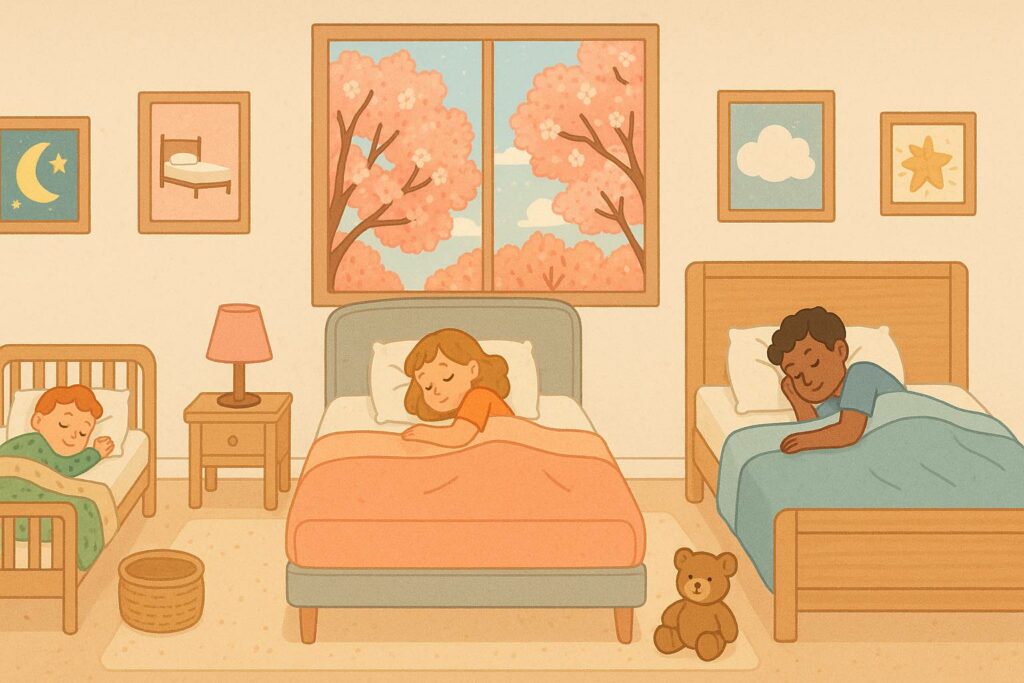🧒 Bed Sizes by Age: The Complete Guide for Kids (US + Global Insights)
Choosing the right bed size for your child isn’t just about age—it’s about safety, space, sleep quality, and future-proofing. From cribs to teen beds, here’s a comprehensive guide to the best bed sizes by age, including how these standards vary around the world.

👶 0–2 Years: Crib Beds
| US Size | 69×132 cm (27×52 in) |
|---|---|
| Best For | Newborns to age 2 |
| Also Called | Standard crib mattress |
| Mattress Depth | 10–15 cm (4–6 in) |
✅ Pro Tips:
- Crib mattresses must be firm and snug-fitting (no gaps!).
- Stick with a tight fitted sheet only—no pillows or quilts.
🌎 Alternatives by Region:
- UK/EU: Common crib size is 60×120 cm (23.5×47 in)
- Asia: Japan’s cribs often use 60×90 cm (23.5×35.5 in)
- Australia: Similar to US (69×130 cm is standard)
👼🏻 2–5 Years: Toddler Beds
| US Size | Same as crib (69×132 cm / 27×52 in) |
|---|---|
| Best For | Ages 2–5, transitioning from crib |
| Frame Type | Low to ground, side rails included |
✅ Pro Tips:
- A toddler bed uses the same mattress as a crib—only the frame changes.
- Great transitional solution before committing to a bigger bed.
🧸 Fun Fact: Many toddler beds are themed—princess castles, race cars, dinosaurs—you name it.
🌎 Global Note:
In the UK, some families skip toddler beds entirely and move straight to a small single (75×190 cm / 30×75 in).
🧒 4–7 Years: Small Single or Junior Beds
| US Equivalent | Not standardized; often 75×165 cm (30×65 in) or custom |
|---|---|
| Best For | Preschoolers, small kids who’ve outgrown toddler beds |
| Frame Height | Still low, with or without guardrails |
✅ Pro Tips:
- Great for compact rooms or bunk beds.
- These are less common in the US, but popular in Europe and Asia.
🌎 Alternatives:
- UK: 75×175 cm (30×69 in) “Small Single”
- EU: 80×180 cm (31×71 in) or 70×160 cm (28×63 in)
- Japan: Compact, often custom-sized junior beds
- Australia: Small singles exist, but most transition directly to regular Singles
👧 6–12 Years: Twin / Single Beds
| US Size (Twin) | 99×190 cm (39×75 in) |
|---|---|
| Best For | School-age kids, bunk beds |
| Also Called | Single bed |
✅ Pro Tips:
- Twin is the most common size for kids after age 5 in the US.
- Works great for bunk beds, trundle beds, and daybeds.
🛏️ Quirk: Twin beds are still referred to as “single beds” in the UK, EU, and Australia.
🌎 Global Match:
- UK/Asia/EU: Single = 90×190 cm (35×75 in)
- AU: Single = 92×188 cm (36×74 in)
📏 10+ Years: Twin XL or Full for Tweens & Teens
🟦 Twin XL
| Size | 99×203 cm (39×80 in) |
|---|---|
| Best For | Tall tweens, early teens |
✅ Pro Tips:
- Adds 5 extra inches in length—ideal for growing kids.
- Standard size in college dorms (makes it future-proof).
🟪 Full (Double)
| Size | 137×190 cm (54×75 in) |
|---|---|
| Best For | Teenagers, solo sleepers who need room. Room for two teenagers when friends visiting. |
✅ Pro Tips:
- Full beds allow room to sprawl—and future guests too.
- Some families skip Twin entirely and go straight to Full.
🌎 Global Alternatives:
- UK Double: 135×190 cm (53×75 in)
- EU Double: 140×200 cm (55×79 in)
- AU Double: 138×188 cm (54×74 in)
🧭 Bed Size-by-Age Summary Chart (US Focus)
| Age Range | Recommended Size | Dimensions (cm/in) |
|---|---|---|
| 0–2 yrs | Crib | 69×132 cm (27×52 in) |
| 2–5 yrs | Toddler (same mattress) | 69×132 cm (27×52 in) |
| 4–7 yrs | Junior / Small Single | ~75×165 cm (30×65 in) |
| 6–12 yrs | Twin | 99×190 cm (39×75 in) |
| 10–18 yrs | Twin XL or Full | 99×203 cm (39×80 in) / 137×190 cm (54×75 in) |
✅ Final Takeaways
- Start small: crib → toddler → twin is the usual US path.
- Twin XL is a smart long-term pick—especially for tall kids.
- In Europe, Asia, and Australia, sizes are similar but labels vary—always check the measurements.
- Guardrails, low bed height, and firm mattresses are key safety considerations through age 6–7.
- If space allows, upgrading to Full by tween years can avoid another mattress swap during high school.